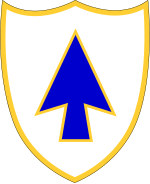U.S. 26th Infantry Regiment
| 26th Regiment 26th Infantry Regiment |
|
|---|---|
 |
|
| Active | 1901–present |
| Country |
|
| Branch |
|
| Type | Infantry |
| Size | Regiment |
| Nickname(s) | Blue Spaders |
| Motto(s) | "Palmam Qui Meruit Ferat" (Let Him Bear The Palm Who Has Won It) |
| Branch Color | Blue |
| Engagements |
Philippine Insurrection World War I World War II Vietnam War Kosovo Campaign Iraq Campaign Afghanistan Campaign |
| Commanders | |
| Notable commanders |
Robert Lee Bullard Theodore Roosevelt Jr. Barnwell R. Legge |
| Insignia | |
| Distinctive unit insignia |  |
| U.S. Infantry Regiments | |
|---|---|
| Previous | Next |
| 25th Infantry Regiment | 27th Infantry Regiment |
The 26th Infantry Regiment is an infantry regiment of the United States Army. Its nickname is "Blue Spaders", taken from the spade-like device on the regiment's distinctive unit insignia. The 26th Infantry Regiment is part of the U.S. Army Regimental System; currently only the 1st Battalion is active and assigned to the 2nd Brigade Combat Team, 101st Airborne Division (Air Assault).
At the beginning of the 20th century, the United States Army was sorely pressed to meet its overseas commitments in Cuba, the Philippines, and Puerto Rico. As a result, in 1901 Congress authorized five additional Regular Army infantry regiments; the 26th, 27th, 28th, 29th, and 30th Infantry.
The 26th Infantry began its life overseas in the Philippines and spent its first 20 years of service on deployments to the Southwest Pacific, the Mexican and Indian frontier and in Europe. It earned its first battle streamer during the Philippine–American War within two years of its forming as a unit.
After returning to the same location for another tour of duty (a habit the Blue Spaders would keep for the entire century), the regiment fought off Mexican bandits and settled disputes in the Indian Territory until it was selected as one of only four Regular Army infantry regiments deemed fit for immediate combat to form the first American Expeditionary Division in June 1917. This expeditionary division would later be renamed the First Division and thus began the regiment's long association with the "Big Red One".
...
Wikipedia
